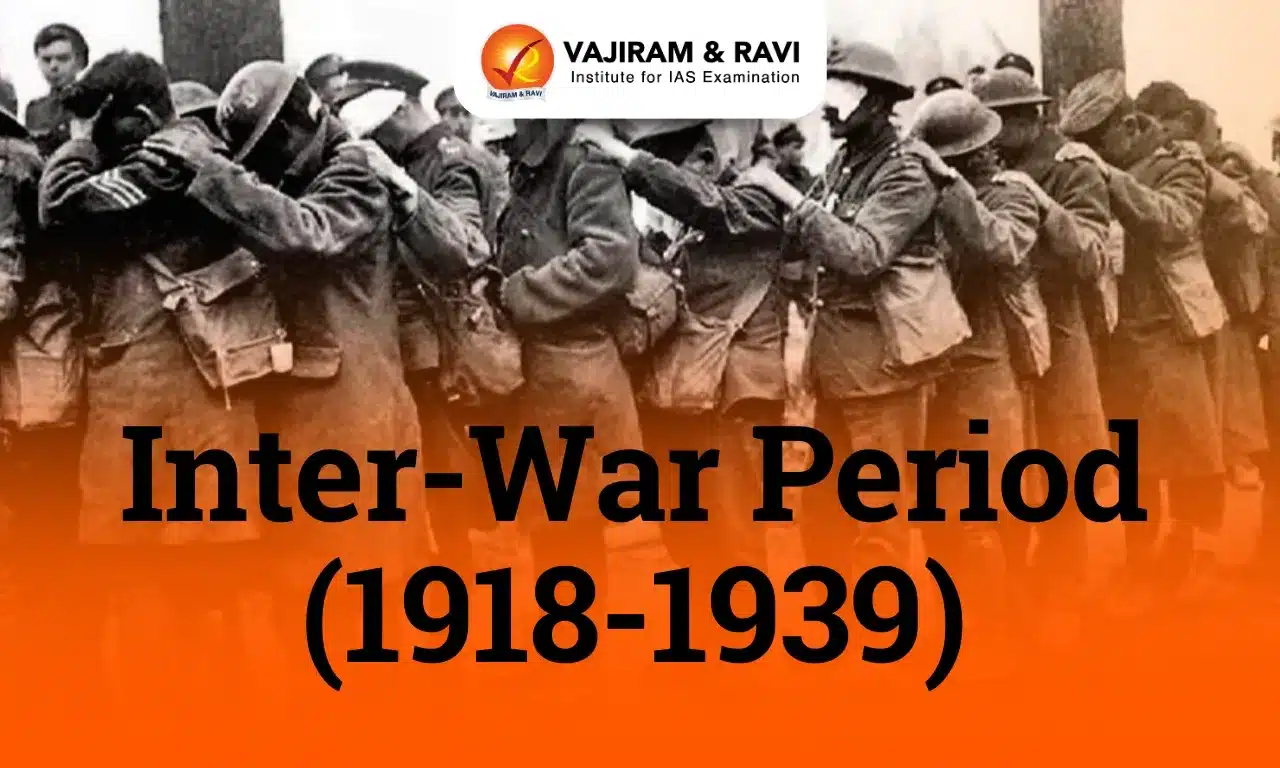The interwar period spanning from 1919 to 1939, was a turbulent era that witnessed the aftermath of World War I and the seeds of another devastating global conflict. Despite the belief that World War I was “a war to end all wars,” the developments during the following two decades led the world towards a more destructive and widespread war.
This period was marked by unresolved rivalries, territorial disputes, the rise of totalitarian regimes, and the failure of international organisations to maintain peace and stability. The interwar years are crucial in understanding the reasons for the outbreak of World War II and the complexities that shaped the global landscape during that time.
League of Nations (1920-1946)
At the end of the First World War, US President Woodrow Wilson’s ‘Fourteen Points’ laid the foundation for the League of Nations. Established in 1920, the League aimed to provide a platform for peaceful resolution of international disputes and avoid future conflicts.
- Founding document: Its founding document, known as the ‘Covenant of the League of Nations,’ consisted of 26 articles covering various aspects of the organisation, including membership conditions, functions of principal organs, mechanisms for peaceful dispute settlement, and the obligations of Member States.
Purpose of the League of Nations
- Multilateral cooperation: The League of Nations ushered in a new era of multilateral cooperation and collective security. Its Covenant bound member states to seek peaceful resolutions to their disputes and renounce secret diplomacy.
- Collective security: The principle of collective security formed the core of the League’s mission, where aggression against any Member State would be considered aggression against all other Member States.
- This principle was invoked when Italy invaded Corfu, leading to economic sanctions against Italy.
- Mandated territories: Moreover, the League supervised mandated territories, such as Palestine and Syria, which were former German and Ottoman territories placed under the administration of mandatory powers until they could become independent states.
Key Achievements of the League of Nations
- Rule of Law: Despite its failure to achieve world peace, the League laid the groundwork for expanding the rule of law globally.
- It strengthened the concept of collective security, giving a voice to smaller nations like Luxembourg and Latvia.
- Economic stabilisation: In the 1920s, the League strengthened economic stability, especially in Central Europe. It aided financial reconstruction in Austria and Hungary, preventing economic collapse.
- It also raised awareness about global issues like epidemics, slavery, child labour, colonial tyranny, refugee crises, and working conditions.
- Resolution of Disputes: The League successfully settled several disputes:
- Between Finland and Sweden over the ownership of the Åland Islands in the Baltic.
- A boundary dispute in Silesia prevented war between Poland and Germany.
- A conflict between Greece and Italy regarding the island of Corfu.
- Border disputes between Greece and Bulgaria.
- New forms of statehood: The League’s mandate system put colonial powers under international observation, paving the way for new statehood models.
- This system eventually led to the independence of nations like Iraq and Lebanon.
Failure of the League of Nations
Despite its noble objectives, the League of Nations faced significant challenges and failures during the 1930s.
- Aggressive nations: Aggressive nations like Japan, Italy, and Germany undermined the League’s authority and sought to exploit its weaknesses.
- Japan invaded Manchuria in 1931, Italy invaded Abyssinia (Ethiopia) in 1935, and Germany remilitarised the Rhineland in 1936, all in violation of the League’s principles.
- World War II: These actions by aggressor nations, rather than upholding the principles of the League, contributed to the outbreak of the Second World War, ultimately leading to the League’s dissolution and the formation of the United Nations.
- The League failed to prevent the devastating war.
Dissolution of the League of Nations
- With the establishment of the United Nations Charter on October 24, 1945, the League of Nations remained active for a brief period.
- However, in April 1946, representatives from 35 of the 46 Member States convened in Geneva to formally approve the dissolution of the League.
- The United Nations emerged as its successor, with a strengthened commitment to international cooperation, peace, and security.
- The League’s legacy, though marked by failures, played a crucial role in shaping the principles and foundations of the United Nations.
The Great Depression
The Great Depression was a severe global economic downturn that lasted from 1929 to 1939, with far-reaching consequences for the interwar period. It was triggered by the stock market crash of 1929 in the United States, but its effects rippled across the world, worsening existing political tensions and contributing to the rise of extremist ideologies.
- Economic consequences: The Great Depression led to widespread unemployment, economic contraction, and social unrest. Businesses failed, factories closed, and millions of people lost their jobs and livelihoods.
- This economic turmoil created an environment of desperation and uncertainty, fueling political instability and public discontent.
- Social and Political impact: The economic hardships of the Great Depression had profound social and political implications.
- Poverty and unemployment rates soared, leading to increased social unrest and the rise of populist and extremist movements.
- Governments struggled to respond effectively, and public trust in existing political systems and institutions eroded.
- Economic Policies and Responses: Governments and economic institutions responded to the Great Depression with various policies, including protectionism, deficit spending, and attempts at economic recovery.
- The United States followed the Keynesian model of growth, by increasing government expenditure to enhance demand in the economy. Soon, other countries followed the model.
- The New Deal in the United States, under President Franklin D. Roosevelt, aimed to revive the economy through government intervention, social welfare programs, and public works projects.
- International implications: It had far-reaching international implications. Trade protectionism and economic nationalism worsened tensions between nations, contributing to the breakdown of international cooperation.
- The economic turmoil also fueled nationalist and extremist movements, which ultimately led to the rise of totalitarian regimes and the outbreak of World War II.
The Rise of Totalitarian Regimes
Fascism is a political ideology and movement characterised by a centralised autocracy, severe economic and social regimentation, and forcible suppression of opposition. It promotes nationalism, military aggression, and complete subservience to the state under a supremely authoritarian leader. Post World War I, ‘fascist ’ movements surfaced in Hungary, Poland, Italy, Portugal, Germany, and Spain.
Fascism in Italy
After World War I, Italy faced economic hardships, social unrest, and a sense of disillusionment among the population. This created a fertile ground for the rise of fascism. Benito Mussolini, a charismatic leader, capitalised on the widespread discontent and promised to restore Italy’s glory and power.
- Mussolini and his Policies: Benito Mussolini founded the National Fascist Party in 1921 and used his private militia, the “Blackshirts,” to intimidate opponents and spread terror.
- In 1922, Mussolini’s Blackshirts marched on Rome, to prevent a civil war King Victor Emmanuel III appointed him as the Prime Minister.
- Once in power, Mussolini established a totalitarian regime. He banned all non-fascist parties, suppressed opposition through imprisonment, torture, and organised killings, and took the title of “Il Duce” (The Leader).
- Mussolini advocated an aggressive foreign policy, aiming to make Italy a great power through military expansion.
- He was very much influenced by Adolf Hitler.
Nazism in Germany
In Germany, the harsh terms of the Treaty of Versailles after World War I, coupled with economic hardships and a sense of national humiliation, created a fertile ground for the rise of fascism. The Nazis, led by Adolf Hitler, capitalised on this discontent and offered a vision of restoring Germany’s power and pride.
- Hitler and his Policies: Adolf Hitler joined the National Socialist German Workers’ Party (Nazi Party) and became its leader in 1921. The Nazis had their paramilitary organisation, the “Storm Troopers” or “Brownshirts,” which used violence and intimidation to suppress opposition.
- Hitler blamed Germany’s defeat in World War I on the Jews and made the extermination of the Jewish race a key feature of Nazism.
- He propagated the idea of racial superiority and the creation of a “Greater Germany” through territorial expansion.
- The economic depression of the 1930s helped the Nazis gain popularity, and in 1933, Hitler was appointed Chancellor of Germany.
- After the Reichstag fire, Hitler suspended civil liberties, arrested opponents, and consolidated his power.
- Following President Hindenburg’s death in 1934, Hitler became the Führer (Leader) of Germany.
- He pursued an aggressive foreign policy, remilitarising the Rhineland in 1936 and annexing Austria and parts of Czechoslovakia through the Munich Agreement in 1938.
- The Spanish Civil War (1936-1939): Itbecame a proxy conflict between ideologies, with the Soviet Union supporting the Republicans and Nazi Germany and Fascist Italy aiding the Nationalists led by Francisco Franco.
Developments in the USSR
The Russian Revolution of 1917 overthrew the Tsarist autocracy and established the world’s first socialist state. The Revolution culminated in the establishment of the Union of Soviet Socialist Republics (USSR) in 1922.
- Response from the Western nations: This new type of state was fundamentally different from the Western notion of a nation-state, causing concern among the USA and Western nations.
- Most European countries and the USA did not recognise the Soviet Union until 1933, and it only became a member of the League of Nations in 1934.
- These countries even appeased Germany against the communist USSR. For example, in the Spanish Civil War.
- As the fascist aggression escalated in the 1930s, the Soviet Union became the only major power actively opposing the fascist forces.
- Stalin’s Policies and the USSR’s Transformation: Joseph Stalin emerged as the leader of the Soviet Union after a power struggle following Lenin’s death in 1924. Believing that war with Nazi Germany was inevitable due to Hitler’s idea of a “Greater Germany” and the appeasement policy of capitalist nations, Stalin adopted two key policies:
- Rapid Industrialisation and Agricultural Development: Stalin implemented a series of Five-Year Plans, starting in 1929, aimed at rapid industrialization and agricultural development.
- The first Five-Year Plan focused on the collectivisation of small farms into collective farms (kolkhozes) to increase agricultural production, often through forcible means and the persecution of kulaks (wealthy peasants).
- The system of forced labour camps (Gulags) for the Russian peasants was very exploitative.
- USSR-Germany Non-Aggression Pact: In 1939, the Soviet Union signed the Molotov-Ribbentrop Pact with Nazi Germany, a non-aggression treaty that divided Eastern Europe into spheres of influence. This pact bought time for the USSR to prepare for the impending war with Germany.
- Authoritarian regime: These policies transformed the Soviet Union into an industrialised and more developed, yet authoritarian regime, with Stalin consolidating his power and suppressing dissent.
Military Fascism in Japan
Japan, which had escaped colonisation, pursued an expansionist policy in the late 19th and early 20th centuries, defeating China and Russia in wars and gaining territories.
- Japan after World War I: After World War I, the League of Nations gave Japan mandates over some former German possessions.
- During the 1930s, Japan’s military became a dominating force in society, destroying democracy and advocating extreme nationalism and expansionism.
- Japan established close relations with the fascist governments of Germany and Italy, seeking a revision of the maps of the world.
- Japan’s occupation of Manchuria: In 1931, Japan, pursuing an aggressive expansionist policy, invaded and occupied Manchuria, a region in northeastern China.
- This act of aggression violated international agreements and demonstrated Japan’s growing militarism and disregard for the League of Nations.
- This further destabilised the fragile international order and contributed to escalating tensions that ultimately led to World War II in the Pacific.
Aggression and Appeasement during the Interwar Period
The interwar period witnessed the rise of aggressive nationalist and expansionist policies by several nations, leading to territorial disputes and armed conflicts. This aggression was met with a policy of appeasement by Western powers, ultimately failing to prevent the outbreak of World War II.
- The Policy of Appeasement: Western powers like Britain and France pursued a policy of appeasement towards the expansionist demands and actions of Hitler, hoping to avoid another war.
- The Munich Agreement of 1938 allowed Nazi Germany to annex parts of Czechoslovakia, demonstrating the failure of appeasement.
- Further, European powers could not do much in Italy’s conquest of Abyssinia in 1935, and Japan’s aggression in Manchuria in 1931.
- The Failure of Appeasement: The policy of appeasement ultimately failed to prevent the outbreak of World War II.
- Aggressive nations continued to make demands and pursue expansionist policies, emboldened by the lack of a firm response from the Western powers.
- The appeasement policy is widely criticised for its naivety and for enabling the growth of totalitarian regimes.
Inter-War Period UPSC PYQs
Question 1: There arose a serious challenge to the Democratic State System between the two World Wars.” Evaluate the statement. (UPSC Mains 2021)
Question 2: What policy instruments were deployed to contain the great economic depression? (UPSC Mains 2013)
Last updated on June, 2025
→ UPSC Notification 2025 was released on 22nd January 2025.
→ UPSC Prelims Result 2025 will be out soon for the CSE held on 25 May 2025.
→ UPSC Prelims Question Paper 2025 and Unofficial Prelims Answer Key 2025 are available now.
→ UPSC Calendar 2026 is released on 15th May, 2025.
→ The UPSC Vacancy 2025 were released 1129, out of which 979 were for UPSC CSE and remaining 150 are for UPSC IFoS.
→ UPSC Mains 2025 will be conducted on 22nd August 2025.
→ UPSC Prelims 2026 will be conducted on 24th May, 2026 & UPSC Mains 2026 will be conducted on 21st August 2026.
→ The UPSC Selection Process is of 3 stages-Prelims, Mains and Interview.
→ UPSC Result 2024 is released with latest UPSC Marksheet 2024. Check Now!
→ UPSC Toppers List 2024 is released now. Shakti Dubey is UPSC AIR 1 2024 Topper.
→ Also check Best IAS Coaching in Delhi
Inter-War Period FAQs
Q1. What was the inter-war period?+
Q2. What happened in the inter-war period?+
Q3. How long was the inter-war period?+
Q4. Why was the inter-war period important?+
Q5. When was the inter-war period?+




















